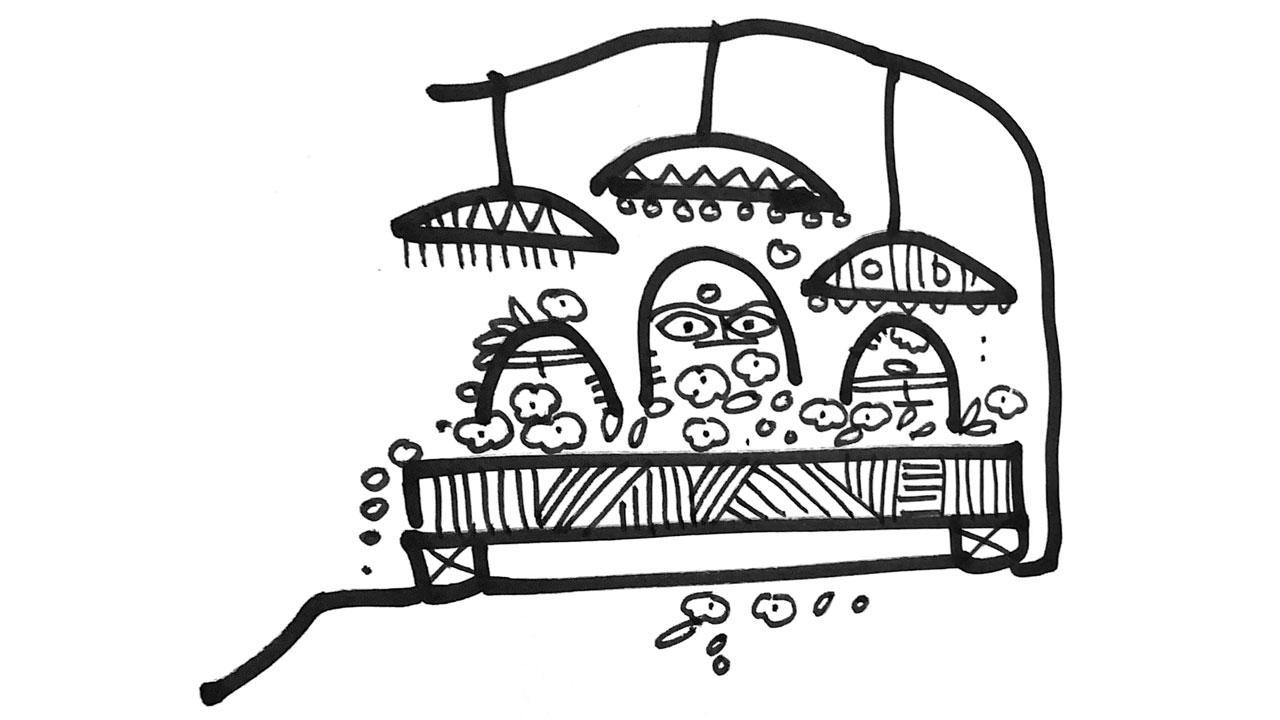Ram’s best friends were the “monkeys” of these Sala forests. He eventually made peace with the “demons” of the same forests.

Illustration/Devdutt Pattanaik
 We are constantly told that Hinduism’s original text is the Veda. That it forms the foundation of Hindu thought. However, much of Hindu practices have roots outside Vedic customs. We often overlook contributions of people who lived outside the Ganga river basin, who were not privy to Vedic prose and poetry, but who nevertheless influenced the composers, as they were neighbours, sometimes friendly and sometimes hostile.
We are constantly told that Hinduism’s original text is the Veda. That it forms the foundation of Hindu thought. However, much of Hindu practices have roots outside Vedic customs. We often overlook contributions of people who lived outside the Ganga river basin, who were not privy to Vedic prose and poetry, but who nevertheless influenced the composers, as they were neighbours, sometimes friendly and sometimes hostile.
The fisherfolk and boatmen of the shifting tributaries of the Indus river basin may have sparked the idea of matsya-nyaya and dharma, and eventually the idea of Vishnu’s first avatar, who rescues the Veda. The traders who took borax (suhaga) through passes of the Himalayas that connected Tibet and Uttarakhand, may have inspired the idea of the wild Bhairava domesticated by the daughters of Brahmins (Sati) and mountain-kings (Parvati).
Matriarchal or matrilineal tribes may have inspired the ideas of apsara, who abandoned husbands and children, the way Urvashi abandons Pururava and Janpadi abandons the twins Kripa and Kripi. Tribal women residing in the northern Deodar forests and the Sala forests of Chhattisgarh, Jharkhand and Odisha may have inspired the idea of forest-dwelling women who married Bhima, and who gave birth to Ravana and Kubera. The Western and Eastern coasts may have inspired the idea of the churning of oceans, by shifting monsoon winds, ushering property, ie giving birth to the goddess of fortune, Lakshmi.
Ram’s marriage to the daughter of Janaka, whose land gave us Buddhism and Jainism and many Upanishadic sages, may have meant the confluence of cultures that venerated fire-rituals and those who venerated celibate holy men. Ram’s best friends were the “monkeys” of these Sala forests. He eventually made peace with the “demons” of the same forests.
Krishna’s transformation from a wrestler, to a cowherd, to a lover of women, to the embodiment of the infinite divine, originally visualised with four arms in the Mahabharata, may be the result of engagement with pastoral communities of Central India, those who built ash-mounds (Govardhana).
The Indo-Greek kings may have introduced ideas of the violent warrior-god Kartikeya, whose name Skanda is closely linked to the Persian name of Alexander, Sikander. Kushan kings had coins with images of a goddess who rides lions, which may have inspired the Jain goddess, Ambika. They also had images of a goddess holding the horn of plenty, which may have later transformed into the Buddhist Lakshmi who appeared on railings of stupas holding pots, and sat in lotus lakes, surrounded by elephants.
The story of lion-riding Durga’s birth by the joint effort of various gods to defeat the buffalo-demon may have inspired, or been inspired by the last hymn of the Rig Veda: the song of collaboration.
The idea of gopikas dancing around Krishna, and yoginis dancing around Shiva, may have roots in old Tantrik practices where women did not marry and lived independent lives. The story of Sati’s corpse being cut and falling across India, may have been inspired by the Buddhist belief of Buddha’s bones being kept in stupas across India. They may have Tantrik roots, including the belief that Shiva is shava (corpse) until Kali enlivens him.
The study of Hinduism reveals much more than the narrow ideas of the Vedic corpus. Yet it was the Veda that was privileged by the British, who were looking for a Hindu “holy book”. And we carry forward this tradition, despite all frothy talk of decolonisation.
The author writes and lectures on the relevance of mythology in modern times. Reach him at devdutt.pattanaik@mid-day.com
 Subscribe today by clicking the link and stay updated with the latest news!" Click here!
Subscribe today by clicking the link and stay updated with the latest news!" Click here!










